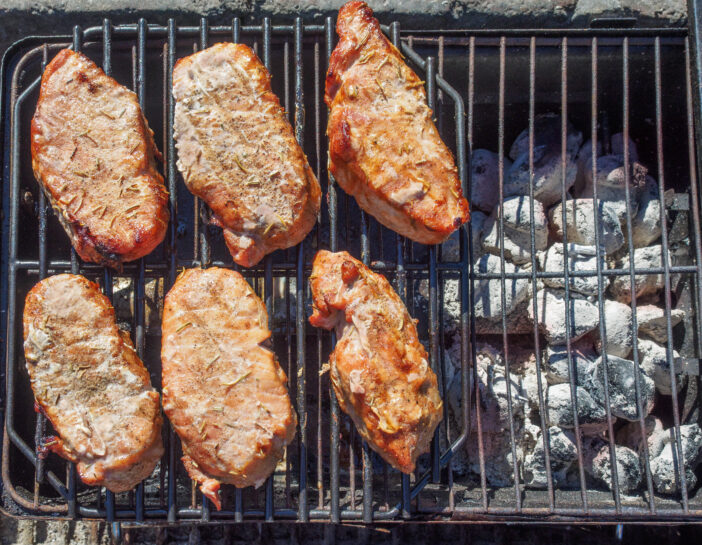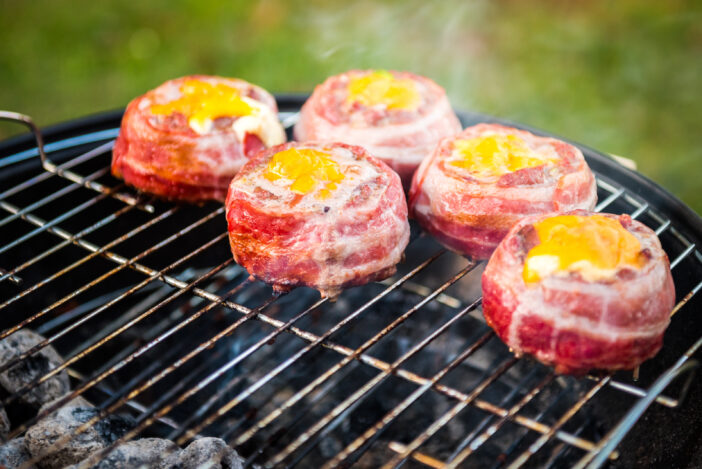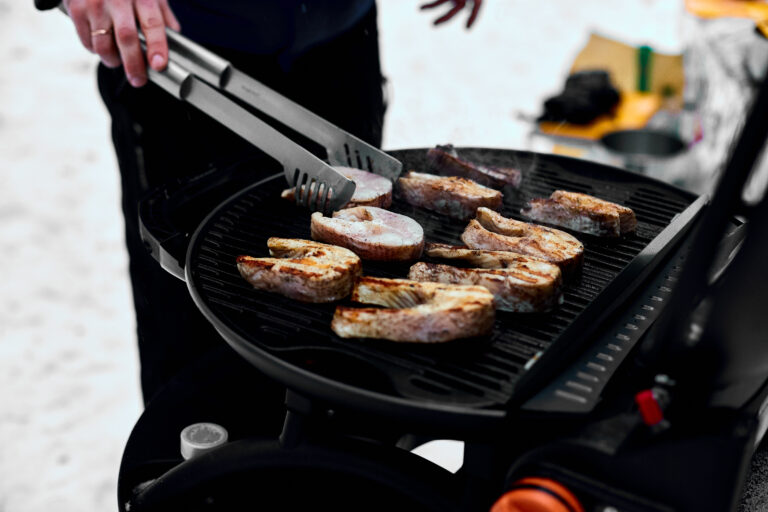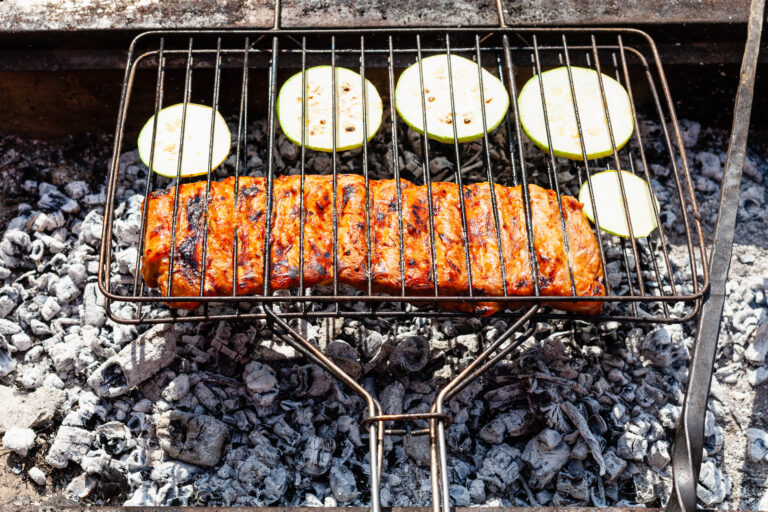5 Indirect Grilling Techniques for Perfect BBQ Meals
Transform your BBQ game with indirect grilling: master equipment, setup, temperature control, techniques for meats, veggies, fruits, and seafood, plus advanced methods and maintenance tips for flavorful success.

Mastering indirect grilling can transform your backyard BBQs into culinary masterpieces. Discover the secrets to perfectly cooked meats and veggies without the risk of flare-ups.
Disclosure: As an Amazon Associate, this site earns from qualifying purchases. Thank you!
Basic Equipment for Indirect Grilling

Mastering indirect grilling requires the right tools. Here’s what you need:
Choosing the Right Grill
Pick charcoal grills for better smoke flavor. Choose gas grills for precise temperature control. Look for models with at least two burners.
Necessary Accessories
Buy a drip pan for catching fat drippings. Use a meat thermometer to monitor internal temperatures. Add a smoker box if using a gas grill. Get heat-resistant gloves to safely handle hot equipment.
Setting Up Your Grill for Indirect Grilling
To master indirect grilling, you need the right setup. Here’s how.
Arranging Charcoal for Indirect Heat
- Divide and Conquer. Split the charcoal into two piles on opposite sides of the grill. This creates a cooler zone in the center where indirect grilling happens.
- Add a Drip Pan. Place a drip pan between the charcoal piles to catch drippings and prevent flare-ups. Fill it halfway with water for added moisture.
- Light the Coals. Ignite only one side and let the heat spread. You want a consistent temperature of around 225-250°F for most meats.
Monitoring and Adjusting Heat
- Turn Off Burners. Light only one or two burners on one side, leaving the others off. This creates a direct heat zone and an indirect heat zone.
- Place a Drip Pan. Position a drip pan under the grill grates, where the burners are off, to catch drippings and add moisture.
- Monitor the Heat. Adjust the lit burners to maintain a steady temperature of 225-250°F. Use a thermometer for accuracy.
With these setups, you’re ready to achieve perfectly grilled dishes using indirect heat.
Mastering Temperature Control
Temperature control is crucial for indirect grilling. Let’s dive into how you can monitor and adjust it for the best results.
Monitoring Your Grill’s Temperature
- Use a grill thermometer. Attach it to the grate for an accurate reading at the cooking level.
- Place probes in food. Insert meat probes into the thickest part of the meat to avoid overcooking.
- Check vent positions. Ensure vents are correctly adjusted to maintain airflow and temperature.
Adjusting Heat Levels During Cooking
- Move coals. For charcoal grills, relocate coals closer or further from the food to tweak heat levels.
- Use burner controls. On gas grills, adjust burner knobs to increase or decrease the temperature as needed.
- Monitor frequently. Regularly check the temperature to ensure it stays in the desired range.
Indirect Grilling Techniques for Different Foods

Using indirect grilling methods enhances your ability to perfectly cook various types of food while retaining moisture and flavor. Below are key techniques tailored to different categories.
Grilling Meats: From Chicken to Brisket
- Chicken: Place chicken on the cooler side of the grill. Maintain a temperature around 350°F, turning occasionally for even cooking. Grill until internal temperature hits 165°F. Use a drip pan to catch juices.
- Pork Ribs: Arrange ribs on the grate away from the heat source. Keep the grill at 275°F, and smoke for 3-4 hours, basting occasionally. Aim for fall-off-the-bone tenderness.
- Brisket: Position brisket fat-side up on the indirect heat area. Maintain a low temperature of 225°F. Slow-cook for 1.5 hours per pound or until internal temp reaches 195°F. Wrap in foil halfway through.
Vegetables and Fruits on the Grill
- Vegetables: Place vegetables like bell peppers, zucchini, and mushrooms on the indirect heat side. Grill at 375°F for 15-20 minutes, turning as needed. Baste with a garlic oil mixture for extra flavor.
- Fruits: Use fruits like pineapples, peaches, and apples. Grill at moderate heat (around 300°F) for 5-10 minutes. Watch them closely to avoid burning. Enhance sweetness with a honey glaze.
- Fish: Place fish fillets skin-side down on indirect heat. Keep grill temperature at 350°F. Grill for 10-15 minutes until fish flakes easily with a fork. Add lemon slices on top for added citrus flavor.
- Shellfish: Arrange shrimp and scallops in a grill pan. Cook over medium indirect heat (375°F) for 5-7 minutes, shaking the pan occasionally. Ensure they’re opaque and slightly firm to the touch.
Mastering these techniques lets you enjoy perfectly cooked meals every time.
Advanced Indirect Grilling Techniques
Mastering advanced techniques ensures you get the most flavor and perfect texture every time you fire up the grill.
Using Wood Chips for Added Flavor
Selecting wood chips like hickory or apple enhances the meat’s taste. Soak them in water for 30 minutes. Place the chips on the charcoal or in a smoker box for gas grills. Keep the lid closed to let the smoky flavor penetrate the food.
Experimenting with Cooking Times and Temperatures
Adjusting times and temperatures is key for different meats. For instance, slow-cook a brisket at 225°F-250°F for up to 12 hours, while chicken wings crisp up beautifully at 300°F for 1.5-2 hours. Track internal temperatures with a meat thermometer to avoid undercooking or overcooking.
Cleaning and Maintenance Tips

Keeping your grill in top shape ensures perfect results every time.
Regular Cleaning Routines
- Scrape the Grates: Scrub the grill grates after each use with a wire brush to remove food residue. This prevents buildup and ensures even cooking.
- Empty the Ash Catcher: Clear out the ash catcher regularly to maintain airflow and avoid flare-ups. This is crucial for consistent temperature control.
- Clean the Drip Pan: Empty and clean the drip pan to prevent grease fires. This simple step keeps your grill safe and ready for the next session.
- Wipe Down the Exterior: Use a damp cloth to wipe down the grill’s exterior. Keeping it clean aids in rust prevention and extends the grill’s lifespan.
- Deep Clean the Grates: Soak the grates in warm soapy water, then scrub thoroughly. This removes deep-seated grime and extends the life of your grill.
- Inspect the Burners: Check for blockages and clean the burner tubes. Ensuring proper gas flow keeps your grill heating evenly and efficiently.
- Check for Rust: Inspect all parts of your grill for signs of rust. Replace any rusty components to prevent structural issues and maintain cooking quality.
- Lube the Hinges: Use high-heat grease to lubricate the hinges and other moving parts. This keeps everything operating smoothly.
By following these tips, you’ll ensure your grill remains in peak condition, delivering delicious results every time you fire it up.
Common Challenges and Solutions
Managing Flare-Ups
Flare-ups can char food and make grilling stressful. Use a drip pan to catch excess fat and trim excess fat from meat. Keep a spray bottle with water handy to tame small flames.
Dealing with Weather Variations
Weather varies, affecting grill temps. Windshields help block gusts that alter heat. Adjust cooking times: add 5-10 minutes for cold, subtract for hot. Monitor grill temp with a reliable thermometer.
Recipes to Try with Indirect Grilling
Experimenting with indirect grilling can elevate your BBQ game. Here are some recipes to get you started.
Simple Starters: Vegetables and Dips
- Grilled Vegetables: Slice bell peppers, zucchini, and eggplant. Toss with olive oil, salt, and pepper. Grill on the cooler side until tender, about 20-30 minutes.
- Stuffed Mushrooms: Remove stems from large mushrooms. Fill caps with a mix of cream cheese, garlic, and herbs. Grill indirectly for 25 minutes.
- Grilled Artichoke Dip: Halve artichokes, brush with olive oil, and grill until soft, about 45 minutes. Serve with a lemon-garlic dip.
Main Courses: Whole Roasted Meats
- Beer Can Chicken: Season a whole chicken with your favorite rub. Place over a half-full can of beer on the grill. Cook indirectly for 1.5-2 hours until internal temperature reaches 165°F.
- Smoked Brisket: Rub a brisket with salt, pepper, and paprika. Smoke on indirect heat for 6-8 hours at 225°F. Use wood chips for added flavor.
- Pork Shoulder: Apply a dry rub to a pork shoulder. Grill indirectly at 250°F for 6-8 hours, or until it reaches an internal temperature of 195°F.
- Grilled Pineapple Rings: Coat pineapple rings with brown sugar and cinnamon. Grill on indirect heat for 5-7 minutes per side.
- Stuffed Peaches: Halve peaches and remove pits. Fill with a mix of mascarpone cheese and honey. Grill for 10 minutes.
- Banana Boats: Slice bananas lengthwise, and fill with chocolate chips and marshmallows. Wrap in foil and grill indirectly for 10-15 minutes.
Frequently Asked Questions
What is indirect grilling?
Indirect grilling is a method where food is cooked on the cooler side of the grill, away from direct heat. This technique allows for slower, more even cooking, perfect for larger cuts of meat and delicate foods.
What equipment do I need for indirect grilling?
You’ll need a grill with a lid, a set of tongs, a meat thermometer, and a drip pan. Using wood chips can also add extra flavor.
How do I set up my grill for indirect grilling?
Set up your grill with coals or burners on one side only. Place a drip pan on the other side to catch fat and prevent flare-ups, then place your food over the drip pan.
What temperatures should I aim for?
Aim for a temperature range of 225°F to 300°F for indirect grilling. Adjust vents or burners to maintain these temperatures.
How do I use wood chips in indirect grilling?
Soak wood chips in water for 30 minutes, then place them directly on the hot coals or in a smoker box. This adds a smoky flavor to your food.
How do I check the internal temperature of the food?
Use a meat thermometer to monitor the internal temperature. Insert it into the thickest part of the meat without touching the bone to get an accurate reading.
What are some commonly grilled foods using indirect grilling?
Popular foods include smoked brisket, beer can chicken, pork shoulder, and grilled vegetables. Each has specific temperature and time guidelines for optimal results.
How do I manage flare-ups?
Use a drip pan to catch fat and reduce flare-ups. If flare-ups occur, move the food to a cooler part of the grill and close the lid until the flames die down.
How do I adjust for weather variations?
Monitor grill temperature closely with a reliable thermometer. Adjust cooking times as needed based on wind, humidity, and ambient temperature.
How do I clean and maintain my grill?
Clean the grill grates after each use, empty the ash catcher, and inspect burner tubes for blockages. Regular maintenance ensures better performance and longevity.
Can you provide some recipes for indirect grilling?
Sure! Try grilled vegetables, stuffed mushrooms, beer can chicken, smoked brisket, pork shoulder, grilled pineapple rings, stuffed peaches, and banana boats, each cooked on the cooler side of the grill for enhanced flavors and textures.






